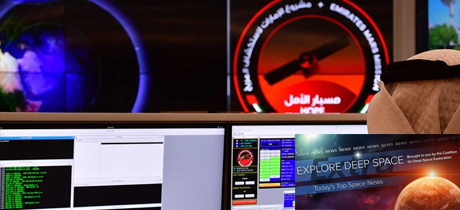In Today’s Deep Space Extra… NASA’s ambitions for the human exploration of the Moon and Mars could mean some difficult negotiations with some potential international partners. Poor launch site weather in Japan prompts a launch delay in the United Arab Emirate’s (UAE) Hope mission to Mars.
Human Space Exploration
What’s in a name when it comes to an “accord”?
The Space Review (7/13): The Artemis Accords, a set of guidelines for cooperation between NASA and other global space agencies in the future exploration of the Moon and Mars as well as finding and making use of its resources, are it turns out more than an extension of the Intergovernmental Agreement that brought 15 nations together for the International Space Station (ISS). The Accords, for instance, are to be bilateral between NASA and each partner in projects like a lunar orbiting, human tended Gateway and lunar surface activities.
Rogozin not interested in cooperating with U.S. on lunar program, prefers China
Spacepolicyonline.com (7/13): During an interview marking the 5th anniversary of Roscosmos, Russia’s federal space agency, its head, Dmitry Rogozin, stated Russia would rather cooperate with China than the U.S. in the future human exploration of the Moon and Mars. Though the U.S. and Russia are seminal partners along with Europe, Japan and Canada in the development of the International Space Station (ISS), Rogozin has been sanctioned by the U.S. for his role in the annexation of Crimea, while he was Russia’s deputy prime minister. He’s also criticized NASA’s Artemis Accords, a set of principles for conduct in the exploration of deep space and the basis of bipartisan agreements that NASA intends to reach with each international partner that joins it in the further exploration of the Moon and Mars.
Why are scientists trying to manufacture organs in space?
Space.com and The Conversation (7/13): The absence of gravity, it turns out, is an asset in the cultivation of tissues and organs for potential transplant. Experiments are underway aboard the International Space Station (ISS). The research can also review how these same tissues and organs of astronauts on long deep space missions respond to the absence of gravity and how to develop countermeasures.
Space Science
NASA’s James Webb Space Telescope (JWST) completes Comprehensive Systems Test (CST)
Coalition Member in the News – Northrop Grumman
NASA Goddard Space Flight Center (7/13): NASA’s technically complex James Webb Space Telescope (JWST), which was recently fully assembled in clean room facilities at Northrop Grumman in Redondo Beach, California, has completed an around the clock, 15-day Comprehensive Systems Test (CST) of the observatory’s software and electrical systems. Coming soon, is an acoustic and vibration test simulating the launch environment followed by another CST. A new launch readiness date for the U.S., European and Canadian space observatory, designated as the successor to the Hubble Space Telescope, is expected this month, replacing the previous target of March 2021. Employees are dealing with workplace restrictions due to the COVID-19 pandemic.
UAE postpones launch of Hope Mars Mission due to weather conditions
Arab News (6/14): Poor weather at the launch site in Japan has prompted the United Arab Emirates (UAE) to postpone the planned launch of Hope, an orbital mission to Mars, from Tuesday at 4:51 p.m., EDT, until Thursday at 4:43 p.m., EDT, which is Friday at 12:43 a.m., in the UAE.
Mars mission: History to be written again by UAE
Gulf News of Dubai (7/13): The United Arab Emirate’s (UAE) Hope orbital mission to Mars, developed in association with the University of Colorado, is set to launch from Japan on Tuesday at 4:51 p.m., EDT. Scheduled to arrive in February 2021, Hope was developed to study the Martian atmosphere and climate. This story was published prior to a delay in the launch until Thursday at 4:43 p.m., EDT, due to poor weather at the launch site.
Review: The sirens of Mars
The Space Review (7/13): This week, is to mark the first of three Mars missions launches this month, first by the United Arab Emirates (UAE), then China, and then NASA. In her book, “The Sirens of Mars,” Georgetown University planetary scientist Sarah Stewart Johnson traces the history of Mars exploration and the looming question of whether the Red Planet once hosted some form of life. And if so, what happened.
Hayabusa2 probe to approach Earth on December 6 to drop asteroid samples
The Mainichi of Japan (7/14): Japan’s Hayabusa 2 asteroid sample return mission is to drop materials gathered from the asteroid Ryugu during 2019 into southern Australia for recovery on December 6 of this year, the Japan Aerospace Exploration Agency (JAXA) announced Tuesday. The spacecraft was launched in December 2014 and reached Ryugu in June 2018. Its journey back to Earth began in November 2019. JAXA and scientists associated with NASA’s Osiris Rex asteroid sample return mission to Bennu, which is still underway, plan to exchange sample materials for analysis. Scientists believe their research will help to explain how water and organics, the building blocks of life, were distributed as part of the planet forming process.
Spectacular photos capture Neowise, one of the brightest comets in decades
CBS News (7/11): Views of the specular comet Neowise from around the world. Neowise is moving from a pre-dawn to an after sunset viewing opportunity for those in the northern hemisphere with binoculars or a small telescope and potentially naked eye as July unfolds.
Other News
Sadly, none of the big rockets we hoped to see fly in 2020 actually will
CSE Members in the News – Aerojet Rocketdyne, Boeing and Northrop Grumman
Ars Technica (7/13): Delays are nothing new to major rocket development. While noting continued setbacks, Ars assesses the likelihood of inaugural launches of seven new launch vehicles in development by NASA and the commercial sector. Updating projections from two years ago, Ars predicts NASA’s Space Launch System (SLS) will most likely liftoff on the Artemis 1 test flight in the first or second quarter of 2022, rather than late 2021.

